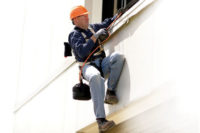All of these scenarios describe potential uses of escape-type respirators. Ideally, escape respirators are small, lightweight, rapidly donned devices that increase the wearer’s ability to escape from a wide variety of situations. They are commercially available for use against industrial chemicals, warfare agents, smoke and combustion by-products.
When selecting and using escape respirators one needs to assess the potential hazards, understand the intended use and limitations of the respirator and, finally, be thoroughly trained prior to use. Because contaminants, concentration levels and safe exposure levels are often unknown in emergency situations, it is important to understand that the use of respiratory protection may only lower exposure levels and help improve the likelihood of a safe escape.
Hazards
Respiratory hazards may exist as particles, gases, vapors or oxygen-deficient environments.At an industrial facility, the most likely cause of respiratory exposure may be a release of contaminants from sources that are normally present. These contaminants, or classes of contaminants, should be readily identified by examining lists of raw materials, Material Safety Data Sheets (MSDS) and process flow diagrams. Placards on trucks or rail cars could also be used to help identify potentially hazardous materials.
In contrast, the contaminants from a terrorist attack are by nature often unpredictable. Industrial chemicals may be used as well as chemical, biological or radiological warfare agents.
Fire also produces a multitude of respiratory hazards including carbon monoxide, soot and many other combustion by-products.
Selection
As best as possible, escape respirators should be selected for the anticipated hazards. There are many NIOSH-approved escape respirators for industrial chemicals. These include gas masks, mouth bit respirators and escape SCBAs. In workplaces that are covered by OSHA, a NIOSH-approved respirator must be selected.For potential terrorist events, selection is difficult due to the uncertainty of the potential hazards. In October 2003, NIOSH published its standard for air-purifying and self-contained escape hood respirators for use against CBRN agents. A variety of tests are described in the standard, including permeation and penetration against sarin (GB) and distilled mustard (HD), fogging, field of view, laboratory respiratory protection level, breathing resistance, carbon dioxide build-up inside the hood, time to don, etc.
Air-purifying escape hoods may be tested for 15-120 minutes against high concentrations of ammonia, cyanogen chloride, cyclohexane (organic vapors), formaldehyde, hydrogen cyanide, hydrogen sulfide, nitrogen dioxide, phosgene, phosphine and sulfur dioxide. They must also have a service life of greater than five minutes at a high flow rate (100 liters/min) for each of the above contaminants. The cartridge is also tested as a P100 particle filter.
Escape hoods should also be evaluated beyond the scope of the laboratory testing according to each user’s needs. Considerations include: fit; time to don; field of vision; breathing resistance; comfort; and can it be conveniently stored.
Training
Training on the escape respirator should be done in conjunction with training on the larger plan for emergency escape (e.g., alarms, escape routes, where to assemble, decontamination, etc). Employees need to know the limitations of their specific escape respirator, i.e. it may not protect against certain substances, only reduces exposure, can be overwhelmed by high contaminant concentration.Remember, choose escape respirators based upon potential hazards and human factors that could affect proper use. Training is imperative if these devices are to afford their intended level of exposure reduction.
